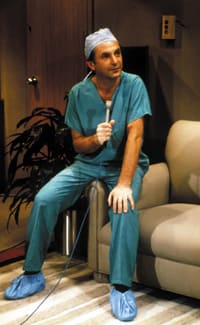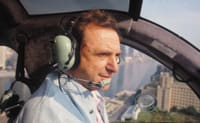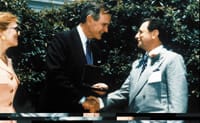Remembering
Dr. Charles Kelman
Those who knew him recall a warm,
witty and worldly genius.
BY JERRY HELZNER, SENIOR ASSOCIATE EDITOR
When golf instructor Kellie Stenzel saw her student, Dr. Charles Kelman (see news story on page 10), walking toward her to begin the day's lesson, she thought she saw something dangling from the bill of his golf cap. As he came closer, she realized that he had attached a 3-foot-long piece of fishing rod to the cap. Stenzel started to wonder if her playful student was up to some kind of practical joke.
But no, it was no joke. Stenzel, a teaching pro at the Atlantic Golf Club in the Hamptons, had been working with Dr. Kelman on his backswing.
|
|
|
|
Dr. Kelman was always comfortable
with a microphone in his hand. |
|
"Like most pros, I told him to get out there and work on what I'd taught him," recalls Stenzel. "But he went a step further. He attached the length of fishing rod to use as a guide to where his backswing should stop. But that was Dr. Kelman. He was always looking to do everything better."
Over the course of teaching golf to Dr. Kelman for about six or seven summers, Stenzel confided in him that she had always wanted to write a golf instruction book for women but wasn't sure she could do it.
"He gave me a copy of his own autobiography -- Through My Eyes -- and I was impressed by how much this great man had to persevere and persist to reach his goals," recalls Stenzel. "He had his share of failures and doubts, but I realized that's what successful people have to go through to be the successes that they eventually become. Dr. Kelman inspired me to continue with my writing."
Kellie Stenzel recently published her third golf instruction book.
"It was always interesting to be around Dr. Kelman," says Stenzel. "He just had a different way of thinking."
What Kellie Stenzel describes as Dr. Kelman's "different way of thinking," I. Howard Fine, M.D., calls an ability to "think out of the box."
Dr. Fine, clinical professor of ophthalmology at the Casey Eye Institute, Oregon Health and Science University, and a leading innovator in cataract surgery himself, says Dr. Kelman gave him sage advice about the perils of trying to introduce something radically new to an established profession.
"He told me this and I never forgot it: 'If you tell people you've got something new. They'll say it won't work. If you show them it works, they'll say it's not useful. If you show them it's useful, they'll say it's not new.'
"In the history of medicine, innovators have always been denounced by the establishment, and Charlie Kelman probably took more abuse than anyone," asserts Dr. Fine. "When he was trying to get phaco accepted, some doctors were practically making a career of saying that Charlie Kelman was a dangerous man offering patients a dangerous procedure. In reality, it was a great procedure that had to be learned and mastered by skillful surgeons."
The situation got so bad, says Dr. Fine, that at one important ophthalmology meeting, a man was allowed to sit by the entrance wearing a sign that read: "I was blinded by phaco."
|
|
|
|
Dr. Kelman learned to fly a helicopter to avoid a long commute to a hospital in New Jersey. |
But Dr. Fine, who considers Dr. Kelman his role model, prefers to remember some lighter moments.
"Charlie was over 70 and he had little kids," says Dr. Fine. "A woman came up to him at a meeting once and complimented him on his beautiful grandchildren. Charlie thanked her but said she had the relationship wrong. They were actually his great-grandchildren. 'Well then you look very good for someone who's a great-grandfather,' she told him."
Dr. Fine tells another story about Dr. Kelman, who owned and flew his own helicopter.
"Charlie is flying another ophthalmologist to a meeting when the door on the passenger side suddenly flips open. The passenger quickly slams it shut. Charlie hears the sound of the door slamming, looks over and says 'Who just got in?' "
And finally, Dr. Fine recounts a story that Dr. Kelman used to tell with great glee.
"It's the early 1970s. Charlie is going from city to city giving presentations on phaco to a different group of doctors each night. It's a grueling tour and Charlie says he needs a night off. So he tells his driver, who's seen the presentation many times, to give the lecture that night. The driver does a good job and then agrees to take questions from the floor. He gets through the first question all right, but the second question is difficult. But the driver says that the question is so easy that even his driver can answer it. So Charlie, sitting in the audience wearing a chauffeur's cap, answers the question perfectly and in detail."
Daniele S. Aron-Rosa, M.D., of Paris, France, who invented the YAG laser and is in the Ophthalmology Hall of Fame, became a close friend of Dr. Kelman's. They gave numerous presentations together that focused on the power of innovation.
"About 25 years ago, an ophthalmologist called me at my hospital to register for my first YAG laser course," says Dr. Aron-Rosa. "He said he was from New York and that his name was Charles Kelman. I was both stunned and thrilled. This was the great Charles Kelman, inventor of phacoemulsification. My husband and I had heard him speak in New York in 1974 and he was so impressive that we ordered our first phaco machine right away. We didn't approach him then, but when we finally met him he was just Charlie, our friend."
Dr. Aron-Rosa recalls the effect of being in Dr. Kelman's presence.
"When he gave a lecture, his huge personality was pushing out the walls and filling the room even before he started to speak," she remembers.
|
|
|
|
Receiving the National Technology Medal from President George H. W. Bush in 1992. |
|
And she recognized his business skills.
"He was a remarkable expert on patents, a rough negotiator, and a brilliant mentor who helped me a lot in my YAG laser patent negotiations. His contributions to ophthalmology were monumental. He trained more than 5,000 eye surgeons in phacoemulsification and performed surgery in 50 different countries. He trained dozens of fellows in New York, and his David Kelman Foundation has provided millions of dollars for fellowships and research."
Robert Sinskey, M.D., clinical professor of ophthalmology at the Jules Stein Eye Institute at UCLA, was a close personal friend and colleague. He has this to say about Dr. Kelman:
"He was a driven man who didn't appear to be driven. He pursued many interests, such as playing the saxophone with some of the greatest jazz musicians of his time, but he was also totally dedicated to ophthalmology. He had a tremendously fertile mind, and like all great innovators who are on the leading edge of change, he wasn't afraid to take risks. Whenever he saw something new that he admired, he'd say 'Why didn't I invent that?' "
In his 1985 autobiography, Dr. Kelman describes how he almost became a teenage singing idol. While doing his residency at Wills Eye Hospital in Philadelphia in the late 1950s, he became acquainted with the record company executive who handled heartthrobs Frankie Avalon and Fabian. Dr. Kelman was, among other things, an aspiring songwriter. He wound up recording one of his own songs, "Telephone Numbers," under the name Kerry Adams. It promptly started to move up the charts. However, when the record company scored with a huge new Chubby Checker hit called "Do the Twist," it stopped pushing "Telephone Numbers" and the song disappeared from the airwaves. (Editor's note: In addition to his many other talents, Dr. Kelman was a terrific writer, as his entertaining autobiography attests.)
One of the last projects Dr. Kelman worked on was a two-piece phakic IOL called the Kelman Duet that requires only a very small incision. Jorge Alio, M.D., of Alicante, Spain, was the first eye surgeon to implant the lens in patients. Here are his remembrances:
"Charles Kelman had a tremendously warm personality. We became friends in just a few days. We talked openly about personal issues that very rarely are shared with anyone else. He was an outstanding creator, a critical scientist, interested in the smallest details in a protocol and in a new design.
"I found it astonishing that from the very first with the Kelman Duet we had a successful design that we only had to change minimally from the original design until the lens was commercially available."
And Gene Currie, the president of Tekia, Inc., which is developing the Kelman Duet, adds:
"My recent contact with Charlie has been a wonderful experience that gave me the honor of working with a true innovator and pioneer. I once heard a colleague refer to him as 'an innovator's innovator.' His approach to innovation was one of 'touch and feel.' He loved working hands-on and understood how to solve problems by doing."
Ophthalmology Management would like to thank those who contributed their remembrances to this article, and especially Robert Sinskey, M.D., and his business manager, Jayne Gordon, for providing us with a copy of Dr. Kelman's autobiography and other background materials. Also, special thanks to Stephanie Bushnell and the American Academy of Ophthalmology for providing the photos for this tribute.











